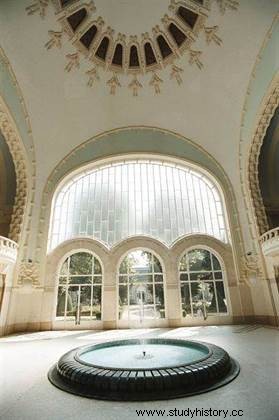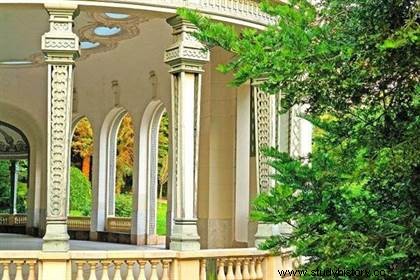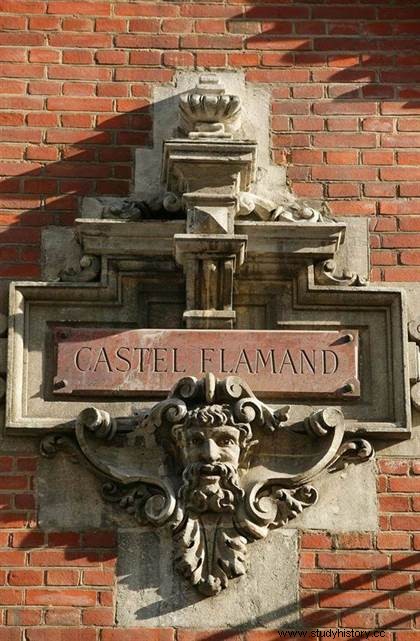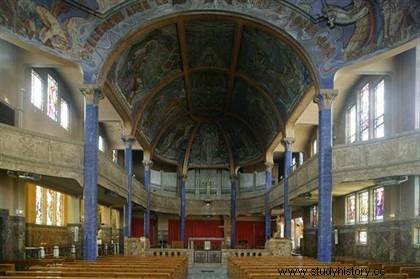 Gingham is a city in the center of France, capital of the district of the department of Allier, whose history is too often reduced to its "government", Marshal Pétain and collaboration. When we evoke it on an economic-tourist level, the city becomes synonymous with spa treatment and care, beauty products or digestive pastilles. Suffice to say that this charming little town that we often imagine lost somewhere in Auvergne does not necessarily enjoy the most attractive tourist reputation. Nevertheless, Vichy conceals an important and interesting heritage both cultural and historical, a heritage dating mainly from the Second Empire, the beginning of the golden age of Vichy, which then became the "queen of spa towns".
Gingham is a city in the center of France, capital of the district of the department of Allier, whose history is too often reduced to its "government", Marshal Pétain and collaboration. When we evoke it on an economic-tourist level, the city becomes synonymous with spa treatment and care, beauty products or digestive pastilles. Suffice to say that this charming little town that we often imagine lost somewhere in Auvergne does not necessarily enjoy the most attractive tourist reputation. Nevertheless, Vichy conceals an important and interesting heritage both cultural and historical, a heritage dating mainly from the Second Empire, the beginning of the golden age of Vichy, which then became the "queen of spa towns".
Vichy:a history that dates back to antiquity
The origins of the city of Vichy, today under the prefecture of Allier with some 27,000 inhabitants, remain uncertain. In Antiquity, the city, answering to the name of aquis calidis (hot water), was already known for the quality and therapeutic virtues of its mineral waters. Many vestiges thus attest to the exploitation of its waters from the Gallo-Roman era. The small city gradually abandoned with the end of the Roman Empire. In the Middle Ages, Vichy was no more than a simple stronghold due to its strategic position at the entrance to Auvergne and a crossing point to cross the Allier. Possession of the Dukes of Bourbon, the city was surrounded by ramparts in the 14th th century, while in 1410 the Célestins convent was founded just above the famous spring.
 The spa activity was not reborn, however, until modern times, thanks in particular to King Henry IV who installed a superintendence of water in the city. A few famous people make it possible to talk about Vichy, including the Marquise de Sévigné, a great accomplished curist or the daughters of Louis XV, Victoire and Adélaïde. The enthusiasm of the Duchess of Angoulême for the city led to the development of a large thermal establishment. The real revolution nevertheless remains to come with the First Empire and especially the Second Empire.
The spa activity was not reborn, however, until modern times, thanks in particular to King Henry IV who installed a superintendence of water in the city. A few famous people make it possible to talk about Vichy, including the Marquise de Sévigné, a great accomplished curist or the daughters of Louis XV, Victoire and Adélaïde. The enthusiasm of the Duchess of Angoulême for the city led to the development of a large thermal establishment. The real revolution nevertheless remains to come with the First Empire and especially the Second Empire.
Napoleon III the benefactor of Vichy
Napoleon III suffered from kidney stones, among other things. In order to heal himself, he decided to make Vichy his ideal spa resort. A major development and beautification project for the city was then designed in 1856, including in particular the drilling of access roads, the creation of parks and buildings such as a town hall or a church. Following the first visit of the Emperor in 1861, the project was launched. In barely a year, the architect Darcy built the Vichy station and the month following its inauguration, Napoleon III was back in the city. Apart from the year, 1865, he will return every year until 1866 in the spa.
 In 1865, a neo-renaissance style casino was built. It is a place of entertainment with shows, ballrooms, games, reading for men or sewing for women. Because if you come to Vichy to get treatment, you come just as much to have fun. In the 19
th
century, an annex was added to accommodate the ever-increasing number of spa guests. Today, it serves as both a convention center and an opera house where many events are organized throughout the summer season.
In 1865, a neo-renaissance style casino was built. It is a place of entertainment with shows, ballrooms, games, reading for men or sewing for women. Because if you come to Vichy to get treatment, you come just as much to have fun. In the 19
th
century, an annex was added to accommodate the ever-increasing number of spa guests. Today, it serves as both a convention center and an opera house where many events are organized throughout the summer season.
From settlers to collaborators
With Napoleon III, the entire Parisian bourgeoisie descended on Vichy to mingle with the greats. However, it was not until 1870 and the end of the work initiated by the Emperor that bathers flocked massively away from the Haussmann building sites in Paris. Hydrotherapy continues to gain momentum under the III th Republic. Let us also keep in mind that one did not necessarily frequent a spa resort – whether it was Vichy or other European cities such as Karlsbad, Baden-Baden or Marienbad – because of a poor state of health but simply because it was appropriate to show off and display one's social status.
But the city bourgeoisie is not the only one to come to recharge its batteries in the sweet and quiet little town, the settlers are also a new clientele of choice. The latter come from all the colonies to treat themselves, in particular liver diseases, damaged by tropical climates and alcohol. In 1903, Vichy had the largest spa establishment in Europe. On the eve of the Second World War, some 2 million annual visitors went to the spa town in the summer months, where the Vichy regime would sound the death knell.
Because of its communication and railway network, close to the demarcation line and above all because of its huge hotel infrastructure, then one of the most important in France after Nice, Vichy became a city designated for the installation of the new French government, seeking to avoid the too working-class Clermont Ferrand. It is a brutal halt for the development of the city while hotels and palaces are distorted to accommodate the French administration. The end of the conflict allows Vichy to hope for a return to normal in the 1950s. Alas, the Algerian war and decolonization deprive it of the majority of its clientele. The golden age of the “Queen of the waters” is long gone, but she nevertheless leaves behind an interesting and original cultural heritage.
The rich architectural heritage of Vichy
 Early XX
e
a second major construction campaign, following that of Napoleon III, was initiated and today bears witness to the extraordinary past wealth of hotels in the city and its countless villas. Walking through Vichy is like taking a historic stroll through the heart of the Belle Époque architecture marked by an undeniable eclecticism with residences ranging from the neo-Gothic style to the neo-Flemish or Venetian style, passing through Art new. These villas were generally rented to spa guests or owned by doctors who, alongside bankers and merchants, were the main sponsors.
Early XX
e
a second major construction campaign, following that of Napoleon III, was initiated and today bears witness to the extraordinary past wealth of hotels in the city and its countless villas. Walking through Vichy is like taking a historic stroll through the heart of the Belle Époque architecture marked by an undeniable eclecticism with residences ranging from the neo-Gothic style to the neo-Flemish or Venetian style, passing through Art new. These villas were generally rented to spa guests or owned by doctors who, alongside bankers and merchants, were the main sponsors.
Spend rue de Belgique to admire the Flemish castle and the Venetian villa, a stone's throw from the boulevard de Russie where the Gothic castle is located or even the villa of Doctor Blancher, this time classic style. And you will always find nearby a hotel also dating from the beginning of the XX e century or even a Second Empire palace like the Aletti, the last palace in the city still in operation. In any case, whether it is a villa or a hotel, you will discover at every street bend a surprising architecture with monumental entrances, ornate balconies and a profusion of decorative elements such as stained glass, glazed domes, etc.
Naturally, hydrotherapy has also left its mark with its health establishments, refreshments and kiosks. Avenue Eisenhower, the large spa establishment in Romano-Byzantine style and the hall of the thermal center of the Domes with its large murals are impressive. And if you need to quench your thirst, just go opposite the Hall des Sources to enjoy a glass of Vichy Célestin, straight from the source, or other mineral waters with various properties, which should be taken into account. be careful when eating them.
Other essential stops, the magnificent Opera mentioned above, as well as the churches of Saint Louis and Saint Blaise. In the first, commissioned by Napoleon III, don't miss the stained glass windows depicting Saint Napoleon. In the second, dive into a universe worthy of Tim Burton with its Art Deco style. However, this is only a quick and non-exhaustive overview of all the architectural richness of Vichy. And the best way to discover it is still by wandering, a wandering that involves passing through the abundant and luxuriant parks of the city.
Bucolic walks and museums
 More than a spa town, Vichy is above all a green town of which 1/5 of its area consists of parks and gardens. The very first were laid out by religious congregations:the Capuchins and the Celestines, follow walks imagined in the 18
th
century, creations initiated under Napoleon I
st
and Napoleon III to recent ensembles such as the exotic garden in front of the station inaugurated in 2009.
More than a spa town, Vichy is above all a green town of which 1/5 of its area consists of parks and gardens. The very first were laid out by religious congregations:the Capuchins and the Celestines, follow walks imagined in the 18
th
century, creations initiated under Napoleon I
st
and Napoleon III to recent ensembles such as the exotic garden in front of the station inaugurated in 2009.
The opportunity also to discover on the edge of the Napoleon III park, the various chalets of the Emperor built for his comfort and that of his entourage. We cannot go around the various green spaces of the city either, but they are really worth the detour and fully contribute to the charm of Vichy, just like these small museums.
Don't wait for the rain to appear before entering. Discover the Opera Museum bringing together the funds of the Opera:programs, costume posters, set projects, photographs, etc. or the Museum of African and Asian Arts which presents interesting and quality temporary exhibitions every year from May to October. Currently, these exhibitions are devoted to African ornaments as well as objects from the cabinets of curiosities, originality and eclecticism of rigour.
Gourmet souvenir
If you are looking to bring back a little souvenir of the region, we recommend that you first stop off at the Vichy market. And to taste the typical cheeses of the region, do not hesitate to come and taste some Auvergne wines at the wine merchant, including the attractive Saint Pourçaint which was in the 14th th century served alongside Burgundy wines at the Court of the Papacy in Avignon.
For lovers of sweets, go to the chocolate confectioner "Aux Marocains" whose name refers to the many colonials from North Africa, who came for treatment in Vichy and who kept their period interior. You will find some historical sweets such as Alma, a hazelnut and almond praline coated in royal icing whose recipe dates back to 1854 and was named in honor of the eponymous battle won during the Crimean War.
Vichy, a city looking to the future
If the memory of the Vichy regime is still present and badly lived in the memories, the city is resolutely seeking to look to the future. With sport taking on an increasingly important dimension, the establishment of a university center bringing youth and dynamism, all combined with a surprising cultural and historical richness and without forgetting the beneficial thermal centers, Vichy constitutes an ideal destination to come recharge both physically and culturally.
To go further
- Vichy, invitation to take a walk, Éditions Lieux Dits, Lyon, 2010.
- Vichy of yesteryear, by Annick Faurot. Hervé Chopin Editions, 2013.
- Vichy Tourist Office:04.70.98.71.94 / www.vichy-tourisme.com
